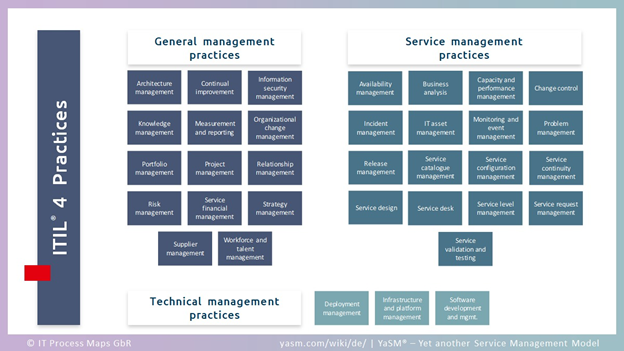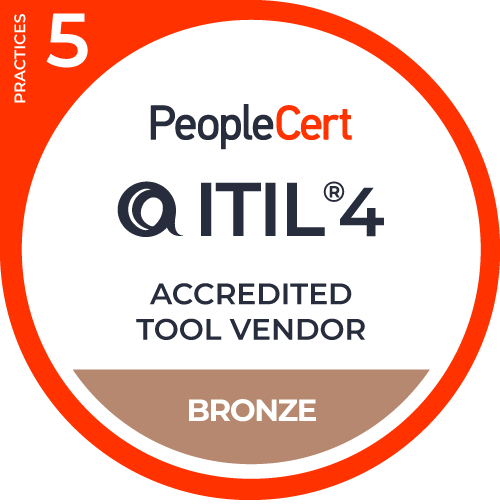Welcome back! We hope you enjoyed our first blog outlining the key changes in ITIL. Following on from that part 2 takes a deeper look under the hood of ITIL to help you to better understand the new practices in the framework, and the increased focus on automation, business analysis, and governance. So, please read on to find out more about ITIL 4 and its new features.
Feature #4: ITIL 4 offers more than just service management best practice
As covered in part 1, ITIL 4 practices have evolved from mere processes and functions in ITIL v3 into a more inclusive framework. Importantly, there are now three categories of practice in ITIL 4:
- General management practices
- Service management practices
- Technical management practices.
This is how they shape up in ITIL 4 (in a diagram provided by yasm.com):

In the above:
- General management practices are practices that are seen in most organizations and have been adapted to align with IT service management (ITSM).
- Service management practices will look familiar to anyone that’s used previous versions of ITIL. All the key players are there including the service desk, problem management, and the artist formerly known as change management, change control.
- Technical management practices that cover deployment management, infrastructure and platform management, and software development and management.
Feature #5: Automation is now the name of the game
Finally, we have a version of ITIL that pays more attention to automation.
We all know that automation can improve speed and efficiency, make life easier for people, and reduce the potential for human error. But the reality is, without the right level of focus, it can be difficult to get the best out of the tools we have at our disposal.
The latest version of ITIL goes a long way to add more practical guidance in getting automation right. It also talks about establishing the groundwork before automating a process to make sure it’s as straightforward as possible. When looking to automate a workflow, look at how it can be simplified before touching the automation technology. Spend some time mapping out the process you’re planning to automate. Does it work as it should? Does everyone understand it? Is it efficient? Make sure it’s fit for purpose before throwing automation into the mix otherwise you’ll only end up redoing it later.
Once you’ve reviewed and simplified your processes, the following are some automation quick win tips:
- Looking for obvious opportunities for automation, i.e. are there any easy wins or known pain points that you can use automation to address? For instance, is the human resources (HR) department spending too long trying to manage the new hire process? You could help them to automate this via a less-manual joiner’s movers and leavers process.
- Continual integration. Automation shouldn’t be a one time thing. Look for opportunities to make frequent, small updates to code so that it’s easy to stay aligned to business objectives and it’s easy to course-correct.
- Progress iteratively with feedback (yes, it’s one of ITIL 4’s guiding principles). Small updates that are easy to verify with the business are the way to go here. That way any benefits are quickly realized and any mistakes are easily fixed.
Feature #6: Governance is now front and center in ITIL 4
Governance is so important, so easy to get wrong, and – all too often – woefully underrepresented at the ITSM table. ITIL 4 goes a long way to address this, so let’s have a deeper look.
First and foremost, what is governance? ITIL explains governance as accountability. Every organization has a governing body, a person or group of people who are accountable at the highest level for the performance and compliance of the organization. Typically, this is the board or the CEO for most companies.
Importantly, governance is more than simply a management committee, and the new version of ITIL clearly sets out the activities needed to accomplish this:
- Evaluate the organization from its objectives to its policies to ensure that everything is in line with stakeholder requirements.
- Direct using the strategies outlined by the board to prioritize organizational activity.
- Monitor the performance of the organization along with its practices and products and services.
ITIL 4 also reminds people that management objectives need to be continually improved to meet the expectations and requirements of customers and stakeholders.
Feature #7: Business analysis has FINALLY been recognized as a service management practice
Business analysis in ITIL 4 is positioned to enable practitioners to analyze a business, define its associated needs, and recommend solutions to ensure those needs are met.
By having business analysis as a management practice (under the service management practice umbrella of course), it means that organizations can communicate their requirements to the IT department in a more meaningful way. All too often, the message can get lost or key requirements can be misinterpreted. It also helps to ensure that the need for change is recognized and that solutions are designed in a way that adds value in line with business goals and objectives.
The key activities carried out by the business analysis practice are:
- Analyzing business systems or problems, really understanding systems, processes, architectures, and services across the corporate environment.
- Identifying and prioritizing parts of an outcome or service that need improvement as well as capturing opportunities for innovation.
- Evaluating and suggesting solutions that will meet both current and future business needs.
- Documenting business requirements in a structured way such that nothing is lost, misunderstood, or forgotten about.
- Recommending solutions after reviewing and validating the requirements with the appropriate stakeholders.
Ultimately, the business analysis practice adds structure so that business needs can be captured, understood, and acted on correctly.
So, that’s our take on some of what’s new in ITIL 4. What would you add to this? Please let us know in the comments.


